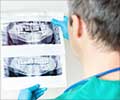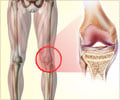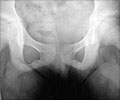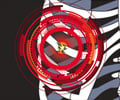- Broken or dislocated jaw - (https://www.nlm.nih.gov/medlineplus/ency/article/000019.htm)
- Mandibular Fractures and Dislocations - (http://patient.info/doctor/mandibular-fractures)
- Biomechanical Evaluation of a Mandibular Spanning Plate Technique Compared to Standard Plating Techniques to Treat Mandibular Symphyseal Fractures - (http://www.ncbi.nlm.nih.gov/pmc/articles/pmc4663366/)
- Osteoporosis and jawbones in women - (http://www.ncbi.nlm.nih.gov/pmc/articles/pmc4547439/)
- Evaluation of the Accuracy of Computer-Guided Mandibular Fracture Reduction - (http://www.ncbi.nlm.nih.gov/pubmed/26163841)
- Bilateral mandibular fracture related to osteoradionecrosis - (http://www.ncbi.nlm.nih.gov/pmc/articles/pmc4455152/)
- Jaw surgery - (http://www.mayoclinic.org/tests-procedures/jaw-surgery/basics/what-you-can-expect/prc-20013370)
- Incidence and pattern of mandibular fractures in Rohilkhand region, Uttar Pradesh state, India: A retrospective study - (http://www.ncbi.nlm.nih.gov/pmc/articles/pmc4623881/)
- Early Experience with Biodegradable Fixation of Pediatric Mandibular Fractures. - (http://www.ncbi.nlm.nih.gov/pubmed/26269728)
- Halazonetis; ‘The 'weak' regions of the mandible', British Journal of Oral Surgery doi:10.1016/S0007-117X(68)80025-3
What is a Broken Jaw?
A broken jaw is caused as a result of an injury or trauma to the jaw. It is a common form of facial injury and it may range from mild soft tissue damage to multiple fractures. Skill and expertise are required in the management of mandibular fractures.
To understand the significance of a broken jaw, it is important to understand the anatomy of the jaw.
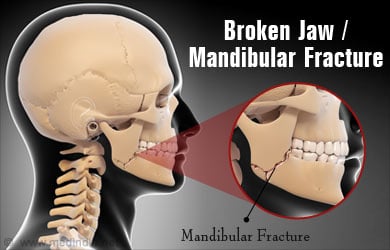
Anatomy of the Jaw:
The jaw consists of the lower jaw or mandible and the upper jaw or the maxilla. The mandible is movable while the maxilla is fixed.
Anatomy of the Mandible:
The mandible or the lower jaw is shaped like a horseshoe, with the ends flattened and projecting upward. The horizontal arch of the mandible holds teeth and blood vessels and is thick in the front, forming the chin. The evolution of the chin is unique to humans and is not present even in the great Apes. Recent ancestors of humans like the bonobos have chins.
At the sides of the head, the projections of the mandible are attached to the temporal bone. These projections are called Rami and they also support muscles that are responsible for chewing.
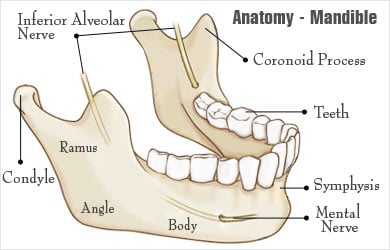
Anatomy of the Maxilla:
The maxilla or the upper jaw is fixed to the bones of the face with its upper arch containing the upper set of teeth.
Infants and fetuses:
In human fetuses and infants, the upper and the lower jaw are present as two separate halves that fuse together in the midline within a few months after birth.
About the joint- Temporo-mandibular joint:
The temporo-mandibular joint has three articulations
- Mandibular fossa
- Articular tubercle
- Head of the mandible
These three surfaces are separated by an articular disc. The joint is, therefore, split into two synovial cavities.
Trauma to the temporo-mandibular joint region can result in:
- Joint dislocation
- Mandibular fossa fracture
- Condylar process fractures
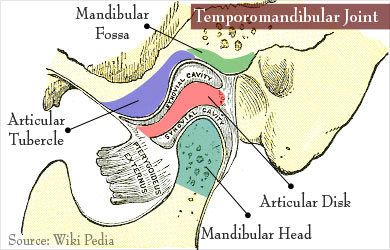
What is the Power of a Bite?
The power of a bite is applied near the joints while the actual function of the bite is performed in the extremities of the jaw. Therefore, for a ten-pound bite, the human jaw muscles need to contract 40 pounds.
Dr. G.E. Black from the Chicago Dental University developed an instrument to test the power of a bite. This instrument, called the gnathodynamometer, was used to test the bite of people from all walks of life. The bite forces varied for different people, depending upon the kind of food they ate and their biting, chewing habits.
- Butcher- 165
- Printer- 270
- School girl- 70
Chewing requires a lot less force as the food is ground by teeth all across the mouth.
The ability to bite is taken as an important reference for the diagnosis of a jaw fracture as the patient will be unable to hold a bite or would find it extremely painful to bite.
What are the Weak Areas of Jaw?
The weak regions of the mandible are determined by two factors:
- The increased probability/ possibility of injury to the site
- Inherent weakness of the jaw
Considering these factors, the weakest sites of the mandible are:
- Angle region- for single site fracture
- Condyle region- for multiple site fracture
What Are the Different Mandibular Fracture Types?
There are two joints that connect the lower jaw to the skull called the temporo-mandibular joints and injury can lead to:
| S.No | FractureType | Details |
| 1 | Open or compound | There is a tear in the skinand the bone is open to the environment |
| 2 | Closed or simple | The bone is not exposed to the environment |
| 3 | Comminuted | The bones may be crushed orthere may be small splinters of bone |
| 4 | Pathological | An already existing diseasecondition may have led to the fracture like fibrous dysplasia |
| 5 | Multiple | The jaw bone may be fracturedat more than one point |
| 6 | Membrane | The bone is dissociated fromsurrounding tissues |
| 7 | Atrophic | Bone atrophy leads tofracture |
| 8 | Impacted | A section of the bone may beforced into another section of bone |
| 9 | Indirect | When a bone fracture occursat a site other than the site of injury |
| 10 | Greenstick | A portion of the bone may bebent while another portion is broken |
| 11 | Dislocation | The bone may have moved fromits position |
| 12 | Complicated | The broken jaw is associatedwith other injuries and conditions |
A broken or dislocated jaw can be treated and fixed after intervention strategies but there are high chances that it could break again.
What Are the Causes for Broken Jaw?
The causes for mandibular jaw fracture are,
- Fights: Assaults or fights are the primary cause of mandibular jaw fracture as this is the most common target of attack during a fight.
- Accidents at workplace: Workers in industries are at high risk for mandibular jaw fracture
- Injury while playing sports: Aggressive sports like boxing, rugby and football increase the risk for mandibular jaw fracture
- Road accidents
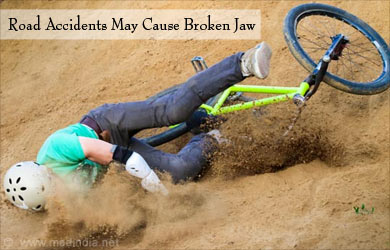
What is the Significance of Road Accidents and Mandibular Fracture?
A study conducted by Kolli Yada Giri and colleagues aimed at determining the etiological factors behind the high incidence of mandibular fractures in the Rohilkhand region, Uttar Pradesh. This study published in the Journal of Oral Biology and Craniofacial Research found that out of the cases of mandibular fractures, a considerable number were caused due to road accidents.
Incidents that cause Mandibular Fracture
- 79.2% - Road accidents
- 11.8% - Assaults
- 9% - Falls
It has been found that road accidents are the leading cause of mandibular fractures in developing countries as strict law enforcements are absent. In developed nations, mandibular fractures are largely caused due to differences among people.
What Causes Spontaneous Mandibular Fractures?
Spontaneous mandibular fractures occur without the application of a traumatic force and commonly due to:
- Osteoradionecrosis
- Osteomyelitis
- Atrophy
- Third molar surgery
- Bone harvesting procedures
- Benign or malignant tumor
Therapy for patients with spontaneous mandibular fractures differs from therapy for mandibular fractures caused due to trauma because patients who were fractured due to trauma are usually young, healthy or with an ability to cope with treatment and healing process. In most instances, spontaneous mandibular fractures are caused when the patient’s health is compromised like after cancer therapy. The patient would be too weak to withstand surgical intervention procedures. Moreover, these patients are normally old and infirm.
What are the Symptoms of Broken Jaw?
A broken jaw is normally caused due to trauma to the region and leads to immense pain in the region. The other symptoms of a broken jaw are:
- Bleeding
- An inability to open the mouth fully
- Swollen appearance of the cheek
- Broken teeth
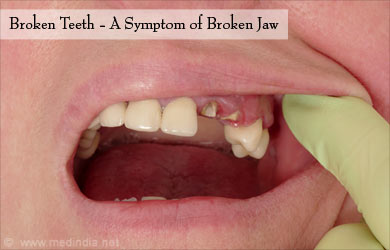
- Malocclusion- the teeth don’t ‘sit’ well
- Difficulty in swallowing food
- Drooling due to improper closure of mouth
- A damaged nerve could lead to numbness of the lower lip
- Difficulty while speaking
What is the First Aid for Broken Jaw?
A fractured jaw requires immediate attention as excessive bleeding could lead to further complications. Another major complication that could arise is difficulty in breathing.
The jaw should be held in place with hand or with a bandage that runs over the head and below the jaw. This bandage should not be tied too tight as the patient may have to remove it in the event of vomiting.
The patient should be rushed to emergency to avoid any complications. Some patients may require a tube to be inserted into the throat if there is difficulty in breathing. Ice packs may be placed at the sight of swelling to prevent further swelling.
What is the Treatment for Broken Jaw?
A broken jaw is treated using corrective surgery. An x-ray would reveal the site of break and if there are multiple breaks in the bone.
The patient is administered with general anesthesia. A surgical cut is made on the gums to reach the site of the broken bones. The broken bones are fixed together using metal plates and screws and then the gums are sutured.
An additional bone may be required for some patients and this bone is taken from the ribs, hips or legs.
In certain cases, an additional cut may be required at the angle of the jaw and this is also sutured together. The sutures will be removed a few days after surgery.
Metal braces are attached to the teeth and elastic bands fixed. This will allow the jaw to heal and will also let the patient move the jaw after surgery.
The metal braces and elastic bands will be removed 4 to 6 weeks after surgery.
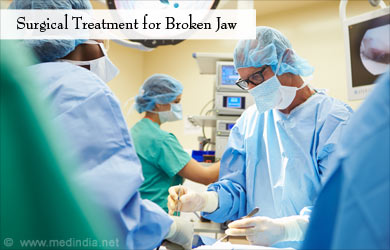
What is the Post Surgical Care?
Patients will be on a liquid to soft solid diet for a few days after the surgery till the jaw heals and the patient is able to swallow food.
The site of surgery should be kept clean to avoid infection while follow-up visits to the doctor are mandatory.
What is Computer-Aided Mandibular Fracture Reduction?
Prior to the advent of computer aided technology, doctors relied on 3D models that were hand crafted. These were rudimentary and basic models which did not have accuracy. Now, computer aided laser sintering offers improved versions which are:
- Detailed and allows better planning for the surgery.
- 3D models that allow more accurate construction of implants which may be required during the surgical intervention of mandibular fractures.
- Faster as they require less time
- Useful for reconstructing models among highly debilitated patients.
What are Biodegradable Plates and Screws?
Plates and screws are used to fix fractures in adults. However, in children, since they are still in the growing phase of their life, growth and natural healing processes would require secondary surgery to remove the plates.
A study conducted by Mazeed to assess the use of biodegradable screws and nuts for pediatric cases that fractures healed well without any serious complications. The advantage of using biodegradable plates and screws are:
- Shorter hospital stay
- No necessity for secondary surgery
- Psychological relief
Health Tips
Since most of the broken jaw incidences occur after road accidents, it is important to:
- Drive safely
- Wear protective gear like helmets while riding a bike
- To never drive under the influence of alcohol
- Ensure that the vehicle is in good running condition
Apart from injury during road accidents, fights with others are also prime causes for a fractured jaw. Choosing friends wisely and staying away from fights will do the jaw and your health good.

